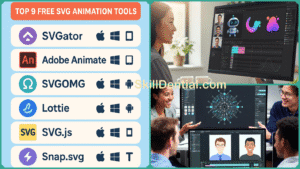Technology plays an increasingly transformative and vital role in assisting students, researchers, and educators as they navigate and overcome key challenges such as effective time management, efficient note-taking, enhanced research productivity, and ensuring the reproducibility of experiments within today’s fast-paced and ever-evolving academic environment.
These digital tools and innovations empower academic communities to streamline their workflows and achieve greater success. Otter AI, ChatGPT, and Comet are three cutting-edge AI tools designed to enhance educational success by addressing distinct pain points while seamlessly integrating into academic workflows. Their combined power frees up valuable time, improves the quality and efficiency of outputs, and fosters collaboration.

This blog post thoroughly explores how these innovative tools effectively serve the diverse and unique needs of undergraduate and graduate students, STEM researchers, and faculty members alike. It provides practical examples, detailed insights, and best practices for harnessing their powerful functionalities in an ethical and highly effective manner.
The primary aim is to empower academics at all levels to confidently leverage these advanced AI technologies, ultimately leading to improved productivity, deeper and more meaningful learning experiences, and significant advancements in research excellence.
Key Concepts and Theories of Otter AI, ChatGPT, and Comet
Otter AI, ChatGPT, and Comet each exemplify unique and distinct aspects of artificial intelligence technology—ranging from advanced speech recognition capabilities to sophisticated generative text creation and comprehensive experiment management systems.
In this discussion, we will explore the fundamental concepts and theoretical foundations that empower each of these platforms, highlighting why they have become indispensable tools in today’s rapidly evolving academic and research environments.
Otter AI
Otter AI is a powerful AI-driven transcription and note-taking tool designed to convert spoken language from a variety of sources, such as lectures, meetings, or interviews, into highly accurate, searchable text in real time. This innovative technology offers a wide range of features, including automated summaries that condense key points, keyword extraction to highlight important terms, and collaborative annotations that allow multiple users to add notes and comments.
These advanced capabilities empower both students and professionals to focus more fully on active listening and meaningful engagement throughout their sessions, rather than becoming distracted or overwhelmed by the necessity of taking detailed manual notes. This enhanced focus allows for a deeper understanding of the material being presented and promotes a more interactive and productive learning or working environment.
ChatGPT
ChatGPT, an advanced and sophisticated large language model developed by OpenAI, functions as a highly versatile AI writing and research assistant. It significantly accelerates the entire process of brainstorming fresh ideas, drafting various sections of essays or in-depth research papers, performing detailed editing, and generating useful study aids or explanations similar to those provided by a personal tutor.
ChatGPT not only enhances the overall quality of writing but also helps users overcome writer’s block effectively, while supporting the exploration and understanding of complex topics by providing immediate access to a vast and diverse knowledge base.
Comet
Comet is a comprehensive machine learning (ML) and data science experiment management platform specifically designed to assist researchers in effectively tracking, comparing, and sharing their experiments throughout the entire development lifecycle.
It addresses the critical challenges associated with reproducibility by offering comprehensive and robust version control for all key components, including datasets, models, hyperparameters, and evaluation metrics. This thorough approach ensures that experiments can be reliably replicated, thoroughly reviewed, and properly audited, thereby enhancing the overall integrity and transparency of the research process.
Comet also enhances team collaboration by enabling seamless communication, detailed documentation, and intuitive visualization tools, all of which are crucial for conducting rigorous scientific research, especially in data-intensive and complex fields where precision and transparency are paramount.
Current Trends and Developments
AI adoption in education is expanding at an unprecedented rate, fundamentally transforming learning and research landscapes. Recent 2025 statistics reveal that 86% of students globally use AI in their studies, with 54% using it weekly and 25% daily, highlighting how quickly these tools have become integral to academic life. In the UK alone, 92% of students incorporate AI, a marked jump from 66% in 2024, emphasizing the steep growth trajectory of AI integration in classrooms.
- Otter AI has become essential for real-time transcription in both virtual and in-person classes. It enables students to capture lectures accurately, review lessons asynchronously, collaborate on shared notes, and reduce the cognitive burden during live sessions by automating note-taking. This increases accessibility and engagement, allowing students to focus on conceptual understanding rather than manual transcription.
- ChatGPT and similar generative AI technologies have significantly altered academic writing and research practices. Studies show that 89% of students use ChatGPT for homework assignments and research support, leveraging it for idea generation, summarization, drafting, and time management. However, ethical frameworks urge students and educators to view AI as a complementary aid rather than a replacement, ensuring academic integrity and genuine learning.
- In the research sector, particularly in machine learning and data science fields, Comet addresses the reproducibility crisis by offering systematic tracking and versioning of experiments. Its seamless integration with tools like GitHub and Snowflake exemplifies a mature, collaborative scientific ecosystem that enhances transparency and efficiency in research workflows.
Overall, these innovative tools clearly illustrate how artificial intelligence is rapidly and profoundly reshaping the landscape of education and academic research by making the learning experience significantly more personalized, efficient, and collaborative.
The steadily growing adoption rates of these technologies highlight their increasing practical value and undeniable benefits to students, educators, and researchers alike, demonstrating a transformative impact on traditional methods and fostering new opportunities for knowledge acquisition and dissemination.
Synergistic Integration of Otter AI, ChatGPT, and Comet for Academic Success
An ideal academic workflow that effectively leverages the combined capabilities of Otter AI, ChatGPT, and Comet can significantly enhance productivity, improve learning outcomes, and increase research rigor by ensuring smooth and seamless integration between these powerful tools:
During lectures or seminars, Otter AI transcribes the spoken content in real time while identifying multiple speakers and highlighting key moments. Automated summaries and keyword extractions are generated, which allow students to engage more deeply without the distraction of manual note-taking.
These Otter transcripts can then be uploaded or fed directly into ChatGPT. Using the AI writing assistant’s capabilities, students or researchers benefit from concise summaries, outlines, custom study guides, and essay drafts generated from the raw transcription.
ChatGPT also helps brainstorm research questions, provides explanations to clarify difficult concepts, and offers editing support — all accelerating writing and comprehension. For STEM students and researchers conducting experiments, ChatGPT-generated hypotheses or insights can drive the design of data experiments.
These experiments are tracked using Comet, which version-controls datasets, models, hyperparameters, and results with rich documentation and visualization. This ensures reproducibility, facilitates team collaboration, and produces rigorous research outputs.
An illustrative example of this workflow in action can be seen in the experience of a graduate student attending an advanced machine learning seminar who:
- Records the entire lecture seamlessly using Otter AI, capturing highly detailed real-time transcriptions and comprehensive summarizations to ensure no important information is missed throughout the session.
- Uploads the complete transcript to ChatGPT, which carefully distills and summarizes the extensive lecture content into well-organized and comprehensive study notes. Additionally, it generates a set of preliminary and insightful research questions to guide further academic exploration and understanding.
- Uses these valuable insights to carefully design and implement comprehensive machine learning experiments that are meticulously tracked and versioned using Comet ML. This platform offers detailed performance metrics and a variety of collaboration tools, enabling seamless sharing of progress and results with advisors, mentors, and peers for enhanced feedback and teamwork.
This integrated approach not only mitigates time constraints and information overload but also overcomes common writing obstacles while maintaining high scientific rigor. By combining Otter AI’s transcription strengths, ChatGPT’s generative writing and research aid, and Comet’s experiment management robustness, students and researchers can build a streamlined, efficient workflow optimized for academic success and collaboration.
This powerful synergy perfectly exemplifies how the latest emerging AI tools can work together seamlessly to significantly elevate overall productivity in the realm of modern academia. By leveraging these advanced technologies, learners are empowered to concentrate more deeply on developing critical thinking skills and fostering creativity. Meanwhile, the AI efficiently manages repetitive, time-consuming, or data-intensive tasks, allowing human intellect to shine where it matters most.
Practical Use Cases: How Otter AI, ChatGPT, and Comet Enhance Academic Workflows
AI-powered tools are fundamentally transforming and reshaping the entire academic landscape in profound ways. Let’s go beyond mere theoretical discussion to provide concrete, practical, and fully integrated workflows.
We will clearly demonstrate how Otter AI efficiently streamlines the process of lecture capture, how ChatGPT significantly accelerates research and drafting tasks, and how Comet guarantees that your machine learning projects remain reproducible, well-organized, and highly collaborative throughout the development cycle.
Undergraduate Student
An undergraduate student who is currently managing the demands of four different courses uses Otter AI extensively to record and transcribe every single lecture they attend. This approach eliminates the need for manual note-taking during class sessions, which in turn significantly enhances their ability to focus more deeply on the material being presented and improves overall comprehension of the subject matter.
After each lecture, the student carefully reviews the transcripts generated by Otter AI, highlighting the most important and relevant sections. They then copy these key excerpts and paste them into ChatGPT, a tool that assists them in quickly generating detailed essay outlines and drafting comprehensive answers to homework prompts.
This streamlined and highly efficient workflow dramatically reduces the time required to manually copy notes or start writing assignments from scratch, enabling the student to manage their coursework more effectively. As a result, they can maintain a strong balance between multiple academic responsibilities without sacrificing the depth or quality of their understanding.
Graduate Researcher in Machine Learning
A data science graduate researcher leverages Comet ML to upload and meticulously monitor experimental logs, including detailed records of model parameters, training metrics, and outcomes across numerous trials.
ChatGPT plays a crucial role by significantly assisting in the generation of comprehensive literature reviews, drafting various sections of research papers, and refining academic writing to ensure it meets rigorous publication standards.
Simultaneously, Otter AI is utilized during advisor meetings to transcribe discussions, decisions, and action points with high precision, guaranteeing that no critical feedback is overlooked and enabling efficient follow-up on tasks.
This seamless integration of the three powerful tools effectively streamlines both the experimental and writing phases of research, substantially enhancing overall productivity and elevating the quality of the research output.
Faculty Member
An instructor effectively leverages Otter AI to record and transcribe lectures, thereby making high-quality class content more accessible to all students, including those with disabilities or who face attendance challenges. This technology ensures that every student has the opportunity to review and engage with the material at their own pace.
Additionally, ChatGPT supports faculty by generating customized quizzes, thought-provoking discussion questions, and even detailed syllabus materials based on class notes and recorded sessions. This allows instructors to save time and tailor their teaching resources more precisely to student needs.
Furthermore, faculty members utilize Comet to oversee student research projects comprehensively, track progress on various experiments, and ensure the ethical, responsible, and appropriate use of AI-assisted technologies in academic work. Altogether, this comprehensive toolset fosters inclusive teaching practices, facilitates effective assessment strategies, and promotes responsible mentorship throughout the academic journey.
In Summary
These use cases clearly demonstrate how Otter AI, ChatGPT, and Comet work together effectively to tackle a wide range of common academic challenges. These challenges include managing demanding and heavy course loads, improving writing efficiency, ensuring research processes are reproducible, and fostering a more inclusive educational environment.
By integrating and adopting this powerful triad of AI tools, academic users can benefit from considerable time savings, enhanced opportunities for collaboration, and ultimately achieve better learning experiences or more successful research outcomes. This combination of tools provides a comprehensive approach to overcoming many of the obstacles faced in academic settings.
FAQs
How accurate is Otter AI’s transcription?
Otter AI uses advanced AI algorithms offering transcription accuracy typically between 85% to 95%, with some users reporting up to 95% accuracy in clear audio conditions. It supports live captioning and multi-speaker identification, though accuracy may decrease in noisy environments, with non-native speakers, or when handling specialized technical language. Overall, Otter AI is reliable for meetings, lectures, and interviews, but may require manual edits for perfect clarity.
Can ChatGPT help with plagiarism concerns?
ChatGPT is best used as an assistant to inspire writing, generate ideas, and help draft or edit content. Users need to maintain originality, properly cite sources, and follow academic integrity policies. Many institutions emphasize responsible AI use, discouraging reliance on AI for wholesale assignment generation, to ensure genuine learning and ethical scholarship.
Is Comet ML free for academic use?
Comet ML offers a free tier tailored to academic and public projects. This allows researchers to track experiments, version control datasets and models, and collaborate with peers. Private projects and advanced features are available under trial or subscription plans. The free tier makes high-quality experiment management accessible to most academic users.
Can these tools be used on mobile devices?
Otter AI and ChatGPT both have mobile-friendly interfaces and dedicated apps allowing access via smartphones and tablets, supporting on-the-go note-taking, writing assistance, or research. Comet ML is a web-based platform optimized for various devices, including mobile browsers, enabling researchers to monitor experiments remotely.
How do these tools enhance collaboration?
Otter AI facilitates note sharing and collaborative annotations among students or team members, enhancing joint study or meeting productivity. ChatGPT can be used in group brainstorming sessions, idea exchange, and writing collaboration. Comet ML supports sharing experiment data, commenting, comprehensive documentation, and version control among research teams, fostering transparent and efficient teamwork.
In Conclusion
Otter AI, ChatGPT, and Comet each represent powerful and innovative AI-driven solutions that address distinct yet complementary aspects of achieving academic success. These tools collectively enhance different stages of the academic process, including efficient and accurate note-taking, accelerated writing and research capabilities, as well as enabling reproducible and well-documented scientific experimentation.
Together, they provide a comprehensive suite of resources designed to support students, researchers, and academics in their pursuit of knowledge and productivity. Their seamless integration into daily academic routines can significantly assist students in managing their time more efficiently, producing work of higher quality, overcoming the challenges of information overload, and fostering effective collaboration with peers and educators.
By adopting these tools ethically and strategically, students, researchers, and educators can unlock new levels of academic productivity, confidence, and achievement. Exploring and mastering these technologies is a worthy investment for anyone committed to thriving in the modern academic landscape.
For further exploration and a deeper understanding, consider integrating these advanced AI tools into your specific courses or ongoing research projects. By doing so, you can closely monitor and analyze how each tool contributes to significant productivity gains, enhances efficiency, and leads to improved overall outcomes in your work. This hands-on approach will allow you to evaluate the practical benefits and tailor the use of AI technologies to best suit your academic or research needs.
Discover more from SkillDential
Subscribe to get the latest posts sent to your email.


